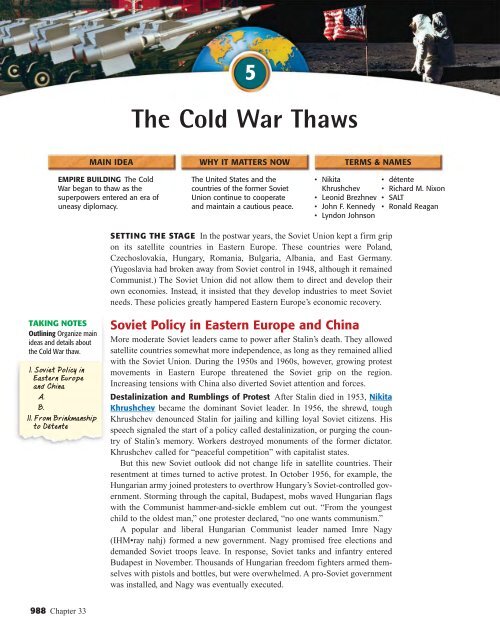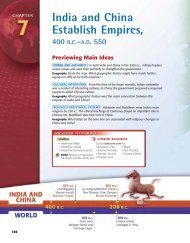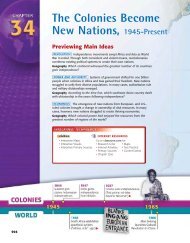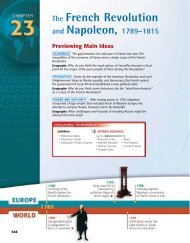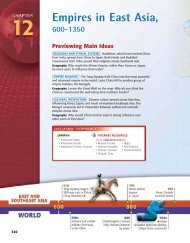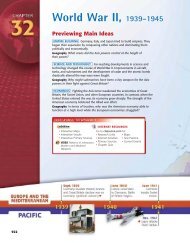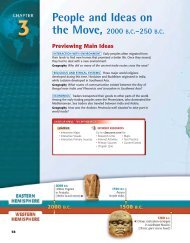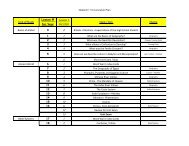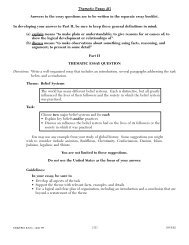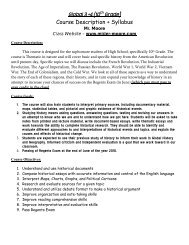Restructuring the Postwar World, - First
Restructuring the Postwar World, - First
Restructuring the Postwar World, - First
Create successful ePaper yourself
Turn your PDF publications into a flip-book with our unique Google optimized e-Paper software.
TAKING NOTES<br />
Outlining Organize main<br />
ideas and details about<br />
<strong>the</strong> Cold War thaw.<br />
I. Soviet Policy in<br />
Eastern Europe<br />
and China<br />
A.<br />
B.<br />
II. From Brinkmanship<br />
to Detente<br />
988 Chapter 33<br />
MAIN IDEA WHY IT MATTERS NOW TERMS & NAMES<br />
EMPIRE BUILDING The Cold<br />
War began to thaw as <strong>the</strong><br />
superpowers entered an era of<br />
uneasy diplomacy.<br />
The Cold War Thaws<br />
5<br />
The United States and <strong>the</strong><br />
countries of <strong>the</strong> former Soviet<br />
Union continue to cooperate<br />
and maintain a cautious peace.<br />
• Nikita<br />
Khrushchev<br />
• Leonid Brezhnev<br />
• John F. Kennedy<br />
• Lyndon Johnson<br />
SETTING THE STAGE In <strong>the</strong> postwar years, <strong>the</strong> Soviet Union kept a firm grip<br />
on its satellite countries in Eastern Europe. These countries were Poland,<br />
Czechoslovakia, Hungary, Romania, Bulgaria, Albania, and East Germany.<br />
(Yugoslavia had broken away from Soviet control in 1948, although it remained<br />
Communist.) The Soviet Union did not allow <strong>the</strong>m to direct and develop <strong>the</strong>ir<br />
own economies. Instead, it insisted that <strong>the</strong>y develop industries to meet Soviet<br />
needs. These policies greatly hampered Eastern Europe’s economic recovery.<br />
Soviet Policy in Eastern Europe and China<br />
More moderate Soviet leaders came to power after Stalin’s death. They allowed<br />
satellite countries somewhat more independence, as long as <strong>the</strong>y remained allied<br />
with <strong>the</strong> Soviet Union. During <strong>the</strong> 1950s and 1960s, however, growing protest<br />
movements in Eastern Europe threatened <strong>the</strong> Soviet grip on <strong>the</strong> region.<br />
Increasing tensions with China also diverted Soviet attention and forces.<br />
Destalinization and Rumblings of Protest After Stalin died in 1953, Nikita<br />
Khrushchev became <strong>the</strong> dominant Soviet leader. In 1956, <strong>the</strong> shrewd, tough<br />
Khrushchev denounced Stalin for jailing and killing loyal Soviet citizens. His<br />
speech signaled <strong>the</strong> start of a policy called destalinization, or purging <strong>the</strong> country<br />
of Stalin’s memory. Workers destroyed monuments of <strong>the</strong> former dictator.<br />
Khrushchev called for “peaceful competition” with capitalist states.<br />
But this new Soviet outlook did not change life in satellite countries. Their<br />
resentment at times turned to active protest. In October 1956, for example, <strong>the</strong><br />
Hungarian army joined protesters to overthrow Hungary’s Soviet-controlled government.<br />
Storming through <strong>the</strong> capital, Budapest, mobs waved Hungarian flags<br />
with <strong>the</strong> Communist hammer-and-sickle emblem cut out. “From <strong>the</strong> youngest<br />
child to <strong>the</strong> oldest man,” one protester declared, “no one wants communism.”<br />
A popular and liberal Hungarian Communist leader named Imre Nagy<br />
(IHM•ray nahj) formed a new government. Nagy promised free elections and<br />
demanded Soviet troops leave. In response, Soviet tanks and infantry entered<br />
Budapest in November. Thousands of Hungarian freedom fighters armed <strong>the</strong>mselves<br />
with pistols and bottles, but were overwhelmed. A pro-Soviet government<br />
was installed, and Nagy was eventually executed.<br />
• détente<br />
• Richard M. Nixon<br />
• SALT<br />
• Ronald Reagan


